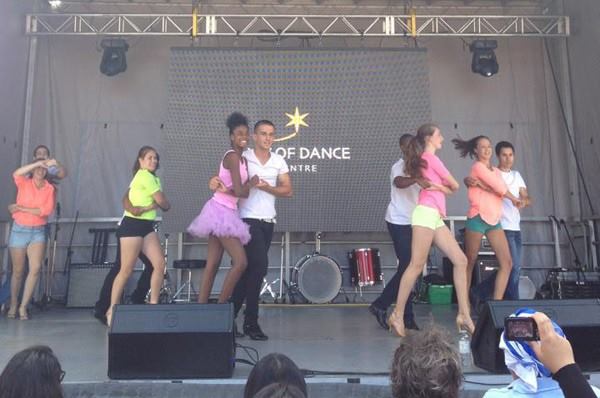Time-Tested Tricks for Overcoming Stage Fright

What if I mess up and fall down? What if they laugh at me? What if I have to become a hermit in the woods to avoid embarrassment? We’ve all been there (yes, even the instructors), and no, stage fright doesn’t go away. But it does become manageable.
Like with the dancer’s nutrition guide, there’s a ridiculous amount of information available about rationalizing performance anxiety in various forms. The problem is, once your brain switches to fight-or-flight mode, it’s not interested in rational explanations – it just wants to get the hell OUT.
I’ve chosen my favourite methods for looking at our fears just a little bit sideways. Because facing fear head on can be overwhelming, but a suggestion out of left field can break it’s momentum and leave you laughing rather than crying.
We’re ALL afraid.
I once participated in an interesting group thought experiment. The speaker asked us to close our eyes and imagine that we were terrified of the people sitting nearby. This was expanded to everyone in the audience, in the city, and eventually the whole world! It was not pleasant, but something was coming.
Surrounded by all these terrified people, it suddenly occurred to me, ‘wait, if they’re all terrified, why the heck am I so scared?’ A moment later, the speaker drove that point home, inviting us to now imagine that everyone was terrified of US! Many of us (myself included) broke out in laughter as we realized how silly our fears were.
Our fear loses it’s power when we realize that we all share performance anxiety – it’s something our peers and even the audience emphasizes with. So remember that you are already an inspiration, just by facing your fears long enough to walk out on stage.
If you’re going to mess up, be unapologetic about it.
It’s ironic how often our dancing suffers out of a desire to avoid drawing the wrong kind of attention. As a wise choreographer once said: ‘small moves look embarrassed, so they’re embarrassing. If you’re going to mess up, make it BIG.’
Most people aren’t even going to notice if you make a mistake, but they’re even less likely to if you plough through it like you meant to do it. ‘Nope, I didn’t mess up, I just threw in a variation.’ Find a way to approach your errors with a sense of humour, and you’ll be invincible on the dance floor.
Follow the salesman’s mantra.
Most of us have a dark opinion of salesmen, but they DO know how to be persistent! They know they’re not going to please everybody, and that’s okay. We can approach our performance the same way, recognizing that mistakes are inevitable, and learning to dance through them rather than be stopped by them.
A used car salesman once taught me the acronym, SWSWSWN: Some Will. Some Won’t. So What? Next. This blunt piece of advice helped me forgive and forget my mistakes on the floor, focusing on the next pattern instead of ruminating about the last. Because the audience LOVES a beautiful recovery.
Let your fear drive you.
Not all fears are of nameless things beyond your control. If you’re worried you won’t be good enough, let that motivate you to practice! Drill that annoying piece of choreo until you couldn’t possibly get it wrong. Let it heighten your awareness so you don’t get lazy during the show.
Actually, even the nameless fears can be given a run for their money. Mantras and visualization techniques can condition you to quell those fears and replace them with more confident thoughts. For example, imagine the audience cheering for you while taking your bow, after delivering a fantastic performance.
Make peace with the worst-case scenario.
Okay, so you might mess up. Your partner or your team might mess up. People might laugh. Your instructor might be disappointed. And that would suck. But what would happen in a day, a week, a month? You would salvage your wounded pride, the audience will forget, and the world will move on.
Sometimes the best way to relieve ourselves from the stress of fear is to imagine the worst-case scenario has already happened. Once we can accept that and put it in perspective, we can calmly take as many steps to avoid that scenario as possible.
Okay, we’re geared up and ready to hit the stage! Next week we’ll finish the series with some final tips for the big day.
About the Author
Ian Crewe has been dancing ballroom for over 18 years, and has a Licentiate in American smooth and rhythm. His passion for dance eventually led him to blogging and the World Wide Web. Ian currently teaches at the Joy of Dance Centre, Toronto, ON, Canada.

